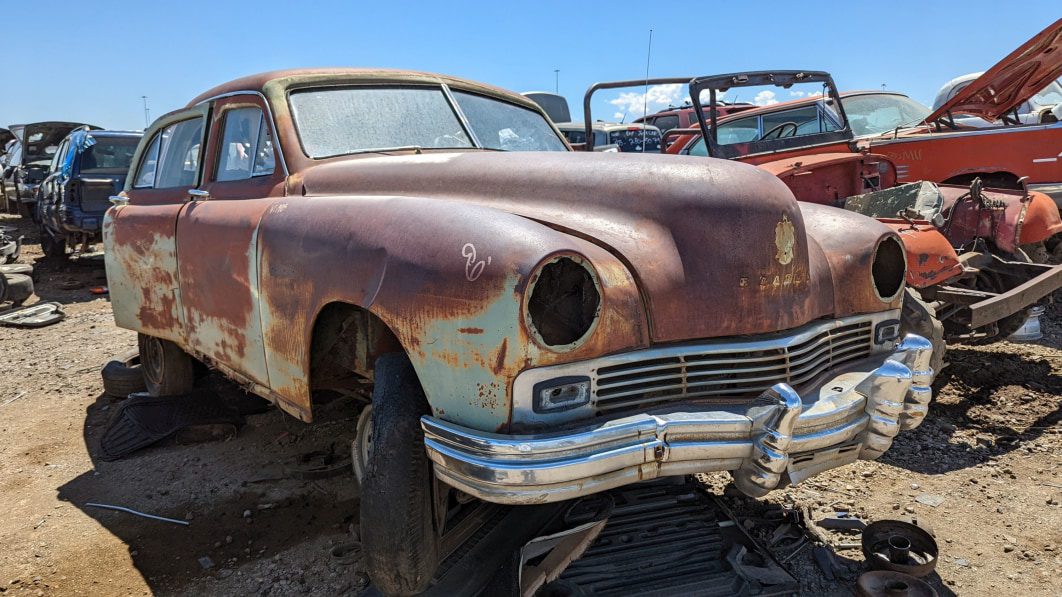Junkyard Gem: 1947 Frazer Manhattan

Cars bearing the Kaiser badge— with its Je suis prêt (I am ready) slogan— were sold for just the 1947 through 1951 model years, so you won’t find many in your local car graveyard these days (though I did manage to find a discarded ’51 Frazer Vagabond a decade ago). That’s a shame, because the contemplation of a weathered Frazer opens a fascinating window into some important automotive history. Here’s one of the first cars ever produced by the Kaiser-Frazer Corporation, now residing in a Denver self-service yard.
Joseph Washington Frazer— yes, that middle name derives from an ancestry that included the first President of the United States— isn’t a household name now, but he played a pivotal role in the formation of Chrysler Corporation (it was Frazer who thought up the name for the Plymouth Division), went on to run Willys-Overland (where he trademarked the Jeep brand) during World War II, and then took over Graham-Paige with the plan of building millions of civilian cars after the war. Lacking capital, he joined forces with industrialist Henry J. Kaiser (who masterminded the company that cranked out 2,710 Liberty Ships during the war) and the two men created the Kaiser-Frazer Corporation.
The company leased the vast Willow Run plant in Michigan, originally built to manufacture B-24 Liberator bombers during the war, and— in true Liberty Ship fashion— came up with designs for two all-new cars seemingly overnight. One was a radical unibody-chassis machine with front-wheel-drive that never made it into production despite plenty of hype during 1946, while the other was a conventional body-on-frame sedan with rear-wheel-drive and a parts-bin powertrain. The second design went into production at Willow Run as a 1947 model, with the Frazer versions priced higher than their Kaiser counterparts. The Manhattan was the top-of-the-line Kaiser-Frazer model, priced at $2,550 (about $35,145 in 2022 dollars) that year. You could buy the lower-zoot Kaiser Special version for a mere $1,868 ($25,745 today).
Ford, GM, and Chrysler were still building prewar designs at this time, so the slab sides of the Kaiser-Frazers looked futuristic by comparison. The postwar shortage of new cars meant that buyers didn’t much care if their ’47s and ’48s were really late-1930s designs, even as streamlined rocket-powered aircraft flew faster than sound, so desperate car shoppers snapped up everything new with four wheels and an engine during the 1946-1948 period (my grandfather bought a new 1946 Crosley as his postwar work car and regretted the decision immediately).
Once the Detroit Big Three had finished the transition from building tanks and bombers to designing and building modern Special Deluxes, Tudors, and Chieftans, though, the party was over for Kaiser-Frazer. Not only did everyone’s 1949 models feature slab-sided bodies, but overhead-valve engines were becoming the Next Big Thing. Cadillac and Oldsmobile boasted brand-new pushrod V8s that year, Chevrolet had offered an OHV straight-six since the 1920s (Buick sold OHV straight-eights starting in 1931), and even the flathead-engine holdouts were jacking up compression ratios and making their old valve-in-block engines seem modern. Meanwhile, Kaiser-Frazer was stuck with the most generic of off-the-shelf engines imaginable: the Continental flathead straight-six.
The history of this engine is so tangled that I’d have to write a doctoral dissertation to do it justice here, but the condensed version is that Continental built engines for other manufacturers (of tractors, aircraft, generators, trucks, cars, you name it) starting in 1905, and eventually more than 100 makes of automobile would be built using some variant of the Continental flathead straight-six. In fact, the very last new flathead-equipped car you could buy in the United States was the 1964 Checker Marathon, which could be purchased with a 226-cubic-inch (3.7-liter) Continental.
Kaiser-Frazers also used the Continental 226 (the later Kaiser Henry J used Willys flathead engines), coupled to a three-on-the-tree column-shift manual transmission. Kaiser-Frazer sales collapsed in 1949, never to recover. Joe Frazer quit the company after endless squabbles with the stubborn Henry Kaiser, and the Frazer brand got the axe after 1951 (when the cars were just 1950 models built with leftover parts).
The last Kaiser-badged cars sold in America were 1955 models, while Jeep production continued under the Kaiser-owned Willys Motor Corporation and then Kaiser-Jeep. Jeep ended up in the hands of American Motors, which was consumed by Chrysler in 1987. We could thus consider today’s Junkyard Gem to be a distant ancestor of the vehicles made by the present-day Stellantis Empire, making it a cousin many times removed of the Opel Grandland Plug-in Hybrid and Peugeot 208. The Kaiser Permanente healthcare company, founded during World War II as a means of providing medical care for Kaiser shipyard employees in California and named after the creek near Kaiser’s cement plant, is the most visible remnant today of Kaiser-Frazer.
Packed with history as it is, this car never had a chance of getting put back on the road after spending decades outdoors in High Plains Colorado. A very nice ’47 Manhattan just isn’t worth much now, sadly, so a rough one is worth its weight in scrap.
Remember, your Kaiser-Frazer dealer is delivering now!











